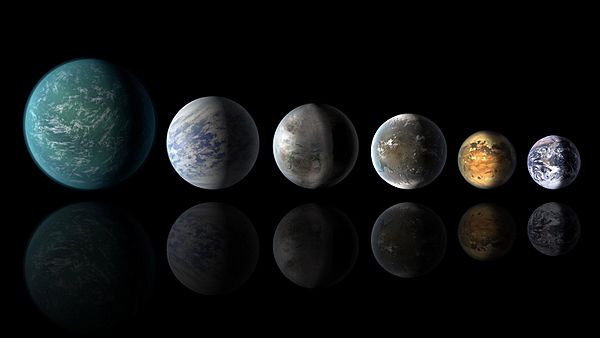Ocean world facts for kids
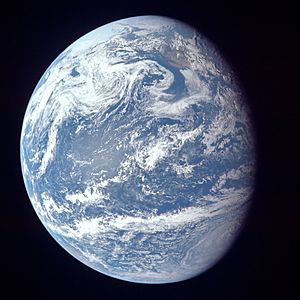
An ocean world is a type of planet or moon that has a lot of water. This water can be in huge oceans on the surface, covering all dry land. Or, it can be in oceans hidden deep under the surface.
Sometimes, "ocean world" can also mean a planet with oceans made of other liquids. For example, Io has oceans of lava. Titan might have inner oceans of ammonia mixed with water, and its surface has lakes of hydrocarbons. Scientists who study oceans on other planets are called planetary oceanographers.
Earth is the only place we know of right now that has liquid water on its surface. But scientists have found many exoplanets (planets outside our Solar System) that might have the right conditions for liquid water. Earth also has a lot of water underground in aquifers. For exoplanets, we can't see surface water directly. So, scientists look for water vapor in their atmospheres as a clue. Studying ocean worlds helps us learn about how planets form and if they could have life.
In June 2020, NASA scientists said that planets with oceans are probably very common in our Milky Way galaxy. They figured this out using computer models.
Contents
Exploring Ocean Worlds
Worlds in Our Solar System
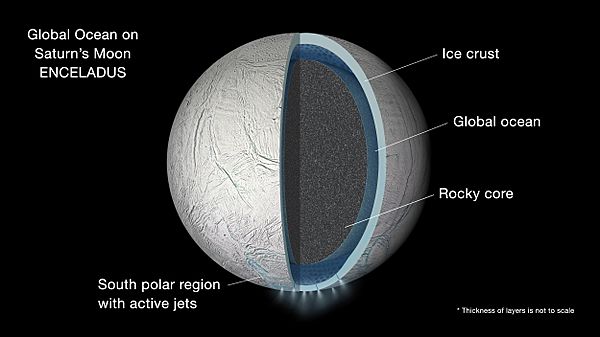
Scientists who study life in space are very interested in ocean worlds. This is because these worlds might be able to start life and keep it going for a very long time. It's easier to study moons and dwarf planets in our own Solar System because we can send space probes there. Exoplanets are usually too far away for our current technology.
Besides Earth, the best-known ocean worlds in our Solar System are Callisto, Enceladus, Europa, Ganymede, and Titan. These all have oceans hidden under their icy surfaces. Europa and Enceladus are especially interesting. They have thin outer crusts, and we've seen signs of cryovolcanism (ice volcanoes) on them.
Many other bodies in our Solar System might also have hidden oceans. These include Ariel, Ceres, Dione, Eris, Mimas, Miranda, Oberon, Pluto, and Triton.
Ocean Worlds Beyond Our Solar System
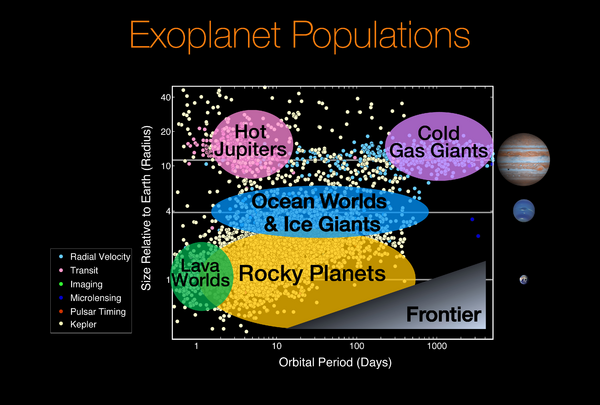
Outside our Solar System, some exoplanets that might be ocean worlds include GJ 1214 b, Kepler-22b, Kepler-62e, Kepler-62f, and planets around Kepler-11 and TRAPPIST-1.
Recently, scientists found that exoplanets TOI-1452 b, Kepler-138c, and Kepler-138d seem to have a lot of water. Also, the rocky planet LHS 1140 b might have a very deep ocean.
Even though 70.8% of Earth's surface is water, water only makes up 0.05% of Earth's total mass. An ocean on another planet could be so deep and heavy that the pressure turns the water into a special kind of ice, even if it's hot. This ice might not be cold like regular ice. If a planet is too close to its star, the water could get so hot it turns into a supercritical fluid. This means it wouldn't have a clear surface.
Even on cooler water planets, the atmosphere could be much thicker than Earth's. It might be mostly water vapor, causing a very strong greenhouse effect. These planets would need to be small enough not to hold onto a thick layer of hydrogen and helium gas. Or, they would need to be close enough to their star for these light gases to be blown away. Otherwise, they would become a warmer version of an ice giant, like Uranus and Neptune.
How Ocean Worlds Formed

Planets that form far away from their star in the early Solar System start as a mix of about half water and half rock. This makes them less dense than rocky planets. Icy planets and moons that form near the frost line (where it's cold enough for ice to form) should have mostly water and rocks. Those that form even farther out can gather other icy materials like ammonia and methane.
Planets can move closer to their star as they form. This is called planetary migration. Since water can dissolve in hot rock (magma), a lot of the planet's water might first be trapped inside its mantle. As the planet cools, water can escape from the mantle to form a steamy atmosphere. This steam can then condense to form an ocean. For an ocean to form, the planet needs to separate into layers (like a core, mantle, and crust). It also needs a heat source, such as radioactive decay, tidal heating (from being stretched and squeezed by gravity), or heat from its early formation.
Planets that formed in the outer, water-rich parts of a disk and then moved inward are more likely to have lots of water. Planets that formed close to their stars are less likely to have water because the inner parts of young star disks are hot and dry. So, if we find a water world close to a star, it's a strong sign that it moved there from farther out.
What's Inside an Ocean World?
Scientists figure out what's inside an icy planet or moon by looking at its overall density, how its gravity pulls, and its shape. Knowing a body's moment of inertia (how hard it is to make it spin) helps tell if it has separated into layers of rock and ice.
Special ways to find hidden oceans include looking at magnetic fields, measuring gravity, and studying how the body wobbles or changes shape due to tides. Radar can also help by looking through ice.
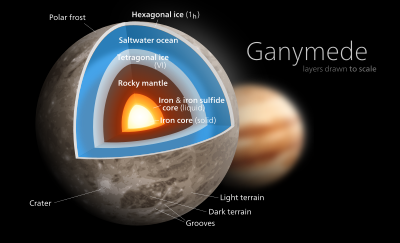
A typical icy moon will have a layer of water on top of a rocky core. For a small moon like Enceladus, the ocean might sit right on top of the rocks, under a solid ice shell. But for a larger icy body like Ganymede, the pressure is so high that the deep ice turns into different forms. This can create a "water sandwich," where the ocean is between two layers of ice.
A key difference is that on small moons, the ocean touches the rocks. This contact can provide heat and chemicals that are important for simple life forms. Because of the changing pressure deep inside, models of water worlds might include water in different forms: steam, liquid, a special "superfluid," high-pressure ices, and even plasma. Some of the solid water could be a type called ice VII.
Keeping a hidden ocean depends on how much heat is made inside and how fast that heat escapes. It also depends on the freezing point of the liquid. So, oceans and tidal heating are closely connected.
Smaller ocean planets would have thinner atmospheres and less gravity. This means liquid water could evaporate more easily than on bigger ocean planets. Scientists think that planets and moons smaller than Earth could have liquid oceans. These oceans would be heated by hydrothermal activity (hot vents), radioactive decay, or tidal flexing.
It's hard for water to erupt as a volcano because water is denser than ice. But recent studies suggest that cryovolcanism (ice volcanoes) can happen on ocean planets with hidden oceans, just like on Enceladus and Europa in our Solar System.
Atmospheres of Ocean Worlds
For surface water to stay liquid for a long time, a planet or moon needs to orbit in the habitable zone (HZ). This is the area around a star where temperatures are just right. It also needs a protective magnetic field and enough gravity to hold onto a good amount of atmospheric pressure. If the gravity isn't strong enough, all the water will eventually evaporate into space. A strong planetary magnetosphere helps protect the atmosphere from the star's wind, keeping water on the planet for billions of years.
A planet's atmosphere forms from gases released during its creation or by capturing gas from space. The surface temperature on an exoplanet is controlled by the greenhouse gases in its atmosphere. These gases absorb and re-release energy from the star. Icy planets that have moved closer to their stars might develop thick, steamy atmospheres. But they could still keep their water for billions of years, even if some of their atmosphere slowly escapes. Ultraviolet light from the star can break down water vapor and cause hydrogen and oxygen to escape into space. This can lead to a planet losing several Earth-oceans worth of water.
During a runaway greenhouse effect, water vapor goes high into the atmosphere. There, ultraviolet light easily breaks it down. This can cause hydrogen to escape into space, leading to the permanent loss of a planet's surface water. It can also cause the surface to become oxidized and oxygen to build up in the atmosphere. How a planet's atmosphere changes depends on the amount of ultraviolet light, how long the runaway effect lasts, how much water it started with, and how fast oxygen is absorbed by the surface. Planets with lots of water should be more common around young stars and M-type stars (red dwarfs).
Scientists have suggested Hycean planets. These are ocean planets with thick atmospheres made mostly of hydrogen. These planets could have liquid water over a wide range of distances from their star. However, newer studies show that hydrogen reacts differently to starlight than heavier gases like nitrogen and oxygen. If such a planet, with an atmosphere 10 to 20 times heavier than Earth's, was at the same distance from its star as Earth is from the Sun, its oceans would boil. These studies now suggest the habitable zone for such worlds is much farther out.
What Are They Made Of?
It's hard to study the surface and atmosphere of exoplanets because clouds can affect the temperature and what we can see. But planets with lots of water in the habitable zone are expected to have unique geology and chemistry. For example, exoplanets Kepler-62e and -62f could have a liquid ocean surface, a steamy atmosphere, or be completely covered in ice. This depends on their orbit and how strong their greenhouse effect is.
The atmosphere's structure and the habitable zone limits depend on how dense a planet's atmosphere is. A less dense atmosphere shifts the habitable zone outward, and a denser one shifts it inward. Scientists think that the atmosphere of water planets in the habitable zone shouldn't be very different from planets with both land and oceans. For their models, they assume that the icy building blocks of water planets are like comets: mostly water, with some ammonia and carbon dioxide. This leads to an atmosphere model of 90% water, 5% ammonia, and 5% carbon dioxide.
Models for Kepler-62f show that an atmosphere with 1.6 to 5 times the amount of carbon dioxide as Earth's atmosphere is needed to keep the surface temperature above freezing.
Could Life Exist on Ocean Worlds?
The features of ocean worlds give us clues about their past and how our Solar System formed. It's also very interesting to think about their potential to start and support life. Life as we know it needs liquid water, a source of energy, and nutrients. All three of these could possibly be found inside some of these ocean worlds. This means they might be able to support simple life for billions of years. In August 2018, researchers said that water worlds could indeed support life.
However, if a planet is completely covered by liquid water on its surface, it might be harder for Earth-like life to exist. It's even harder if there's a thick, solid ice layer between the global ocean and the rocky mantle below. Simulations of a hypothetical ocean world with five times Earth's amount of water showed that the water wouldn't have enough phosphorus and other nutrients. These nutrients are needed for Earth-like ocean life, like plankton, to produce oxygen. On Earth, phosphorus washes into the oceans from rain hitting rocks on land. This wouldn't happen on a pure ocean world.
Simulations of ocean planets with 50 times Earth's amount of water showed that the pressure on the seafloor would be so huge that the planet's inside wouldn't have plate tectonics. Plate tectonics causes volcanoes, which provide the right chemicals for life on Earth.
On the other hand, small bodies like Europa and Enceladus are thought to be good places for life. This is because their oceans are likely in direct contact with their rocky cores. The core can provide both heat and important chemical elements for life. Also, geological activity on their surfaces might bring important building blocks into the oceans. These could be organic molecules from comets or special chemicals called tholins, which form from sunlight hitting simple organic compounds.
Oxygen and Life
Molecular oxygen (O2) can be made by natural geological processes. It's also a byproduct of photosynthesis by living things. So, even if we find oxygen, it doesn't always mean there's life. In fact, planets with a lot of oxygen in their atmosphere might not be good for life. It could be hard for early life to start if there's a lot of oxygen. This is because early organisms used energy from chemical reactions with hydrogen compounds. On an oxygen-rich planet, organisms would have to compete with the oxygen for this energy.
See also
 In Spanish: Planeta océano para niños
In Spanish: Planeta océano para niños
- Circumstellar habitable zone
- Desert planet
- Earth analog
- Extraterrestrial liquid water
- Ice planet
- List of extrasolar candidates for liquid water
- Ocean § Extraterrestrial oceans
- Panthalassa
Space missions to water worlds in the outer Solar System:
- Enceladus Explorer
- Enceladus Life Finder (ELF)
- Europa Lander
- Explorer of Enceladus and Titan (E2T)
- Journey to Enceladus and Titan (JET)
- Jupiter Icy Moons Explorer (JUICE)
- Laplace-P
- Life Investigation For Enceladus (LIFE)
- Oceanus
- Testing the Habitability of Enceladus's Ocean (THEO)
- Titan Lake In-situ Sampling Propelled Explorer (TALISE)
- Titan Mare Explorer (TiME)
- TOI-1452 b
- Triton Hopper


